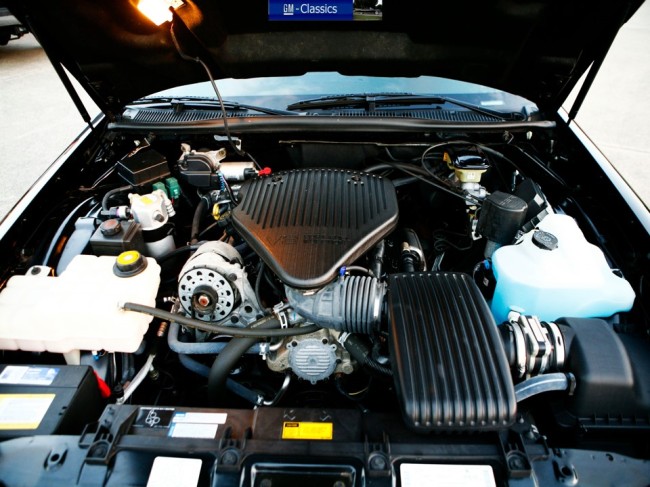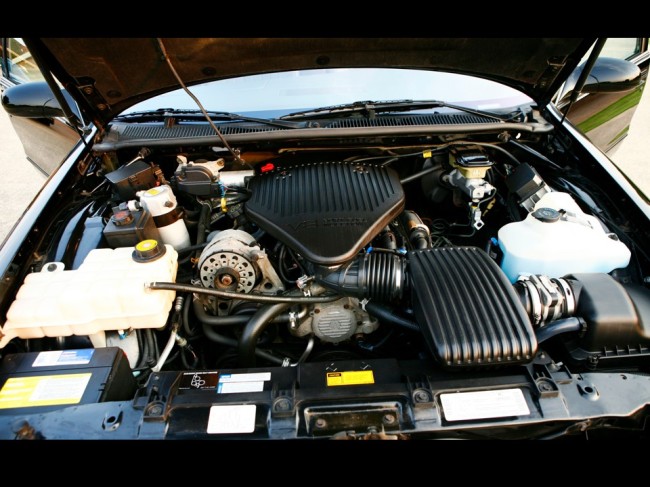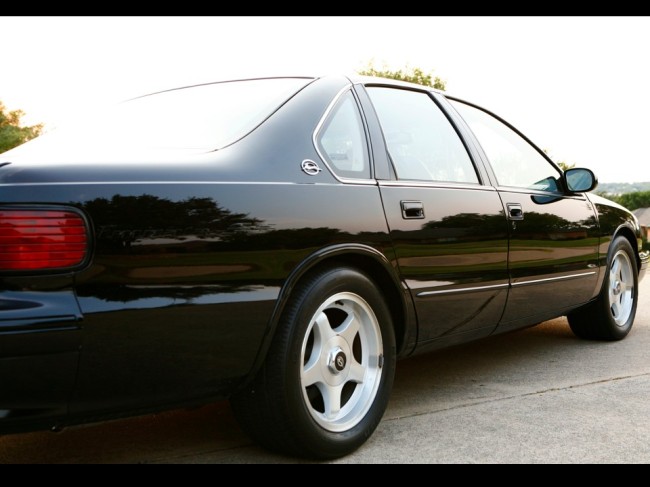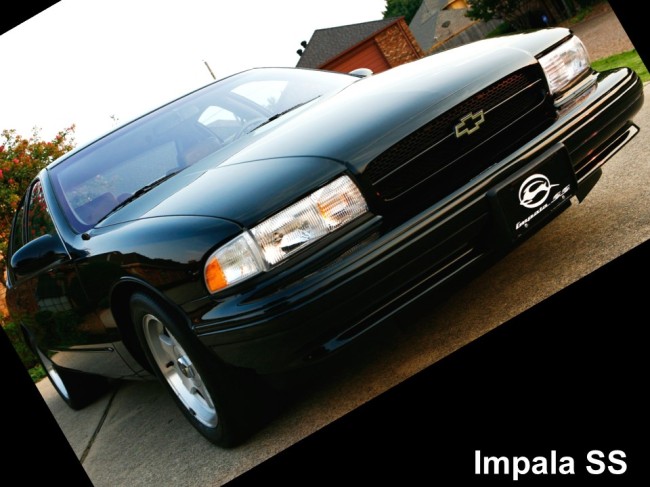5.7 litre LT1: 1996 Fleetwood & 1996 Impala SS
What do these cars have in common?
The formidable 5.7 litre 350 CID 16-valve LT1 powered both
What do these two automobiles have in common besides both of them being GM products? A Cadillac Fleetwood Brougham and a Chevrolet Impala SS are a highly unlikely pair. One is decadently luxurious and the other is built for high performance. The 1996 model year was the finale for the full-size “B-body” rear drive cars. They both shared the second generation 5.7 litre LT1 V8 engine introduced in 1992 by the Corvette.
They both share the same “B-body” platform. (I used the “B” connotation for both cars to show the superfluous design for those of you who think I intentionally made an error! I was being the quintessential smart ass here to make a point, a CHEVY power plant under the hood of a Cadillac Fleetwood? SHAMELESS! Sure the Caddy uses the “D” platform but it is still cut from the same cookie cutter!) Their high performance camaraderie changed the way one thought of American cars. The 1996 Fleetwood Brougham retained its classic Cadillac elegance and style. The dramatically aerodynamic and powerfully sporty 1996 Impala SS was a spacious and understated. This was a unique encore duet performance in the continuing saga of “As the Standard of the World Turns.”
Two complete opposites at each end of the spectrum…luxury and performance were elements for each car. The heart of the camaraderie was the 5.7 litre LT1 V8 engine, yes, they were both powered by “the Heart-beat of America.” The formidable 5.7 litre 350 CID LT1 V8 engine combined efficiency, emissions compliance, durability, and performance.
It was first introduced as the second generation of the 5.7 litre LT1 in the 1992 Corvette. The differences being both the Fleetwood and the Impala SS used cast iron cylinder heads, a camshaft designed for low-end torque rather than high-end hp, and 2-bolt main bearing caps. The Vette used aluminum cylinder heads and 4-bolt main bearing caps.
Cadillac with 5.7 litre LT1
The 5.7 litre LT1 V8 engine was a highly sophisticated not to mention adaptable powerplant. It used exhaust manifolds with tri-layered stainless-steel gaskets to reduce exhaust leaks and improve durability. Copper lead cam bearings replaced the cadmium bearings previously used.
The LT1 featured platinum tipped spark plugs and low resistance ignition wires that improved idle quality and cold starts. The pistons were revised using a positive-twist top ring that improved the ‘piston-to-cylinder’ seal and reduced blow by emissions at high engine speeds.
Sequential Fuel Injection (SFI) optimized combustion by using input from the PCM to precisely match fuel delivery to each cylinder’s intake stroke. SFI is designed to provide smooth idle, impressive overall operation, and precise emissions control. The Powertrain Control Module (PCM) monitored the emissions controls and its components to detect deterioration or malfunction.
It also controlled individual fuel injectors, optical ignition system, and interacted with the electronic transmission. A mass airflow sensor provided accurate information regarding air entering the engine that the PCM used to determine the fuel requirement for maximum efficiency.
Chevrolet with 5.7 litre LT1
A low-restriction intake and air filtration system allowed the engine to breathe freely for efficiency and met federal noise relations. Cylinder head ports and weight saving one-piece intake system improved air flow into combustion chambers for a clean-burn enhancing power and efficiency. The reverse flow cooling system circulates coolant thru dedicated cylinder heads BEFORE the engine and radiator providing a higher compression ratio for more power.
A gear-driven coolant pump virtually eliminated side-load stress providing uninterrupted coolant flow even if a belt breaks. The 5.7 litre LT1 included an oil change monitor that calculated and displayed the condition of the engine oil. An oil level sensor alerted driver should engine oil drop one-two quarts, unlike the traditional systems that alert the driver AFTER the engine is cooked from friction due to low to no engine oil situations. A heavy-duty upgraded oil pan substituted the standard version.
The second generation 5.7 litre 350 CID 16-valve LT1’s operating range extended hundreds of rpm beyond most OHV V8 engines giving the LT1 the low-speed thrust of a traditional push-rod engine and the high-speed performance of an OHC design. It was the best of both worlds.
The 1996 Cadillac Fleetwood Brougham’s 5.7 litre produced 260 hp @ 5,000 rpm with 447 Nm of peak torque @ 3,200 rpm. Performance was rated as 0-60 mph in 8.2 seconds, 0-100 mph in 22.3 seconds with a top speed of 142 mph. It did the ¼ mile @ 88 mph in 16 seconds. The engine used Sequential Port Fuel Injection controlled by the Powertrain Control Module (PCM) with a paper element fuel filter and electric in-tank fuel pump.
GM’s Turbo Hydra-Matic 4L60-E 4-speed automatic transmission was equipped with electronic shift control, torque converter clutch, and overdrive. Emission controls included (AIR) Air Injector Reactor with Computer Command Control (CCC), (EGR) Exhaust Gas Recirculation with controlled flow, 3-way warm-up catalytic converter, Evaporative Emission Control with charcoal canister, and (PVC) Positive Crankcase Ventilation.
The Impala SS 5.7 litre 350 CID 16-valve LT1 produced 260 hp @ 5,000 rpm with 447 Nm of peak torque @ 2,400 rpm. Performance was rated as 0-60 mph in 7.4 seconds, 0-100 mph in 20.8 seconds with a top speed of 142 mph. It did the ¼ mile @ 88 mph in 15.4 seconds.
It was mated to GM’s Turbo Hydra-Matic 4L60-E 4-speed automatic transmission. Most Impala SS owners usually rebuild the standard basic automatic transmission to the T-56 manual transmission used by the Camaro and Firebird. With all of the power/torque thrust available, the transmissions usually require service at 100,000 miles.
There were also other hp versions of tune for the 5.7 litre LT1, one was tuned to produce 300 hp @ 5,200 rpm and one was tuned to produce 285 hp @ 5,200 rpm. The trusty 5.7 litre 350 CID V8 was an extremely popular GM powerplant.
The chassis for this brute was upgraded with the 9C1 police interceptor package which included a tuned and lowered suspension, reinforced springs, high-capacity reverse-flow cooling system, large 12.1” disc brakes, transmission cooler, dual exhaust, and a high-output electrical system.
Both Cadillac Fleetwood and Chevrolet Impala SS were large front engine rear drive vehicles built as body on frame construction built on a ladder-type frame. The Impala SS rode a 115.9” wheelbase, was 214.1” long and 77” wide. The Fleetwood Brougham rode a long 121.5” wheelbase, had the luxury length of 225.1” and was 78” wide.
The Impala SS began as the brainchild of Jon moss, then Manager of Chevrolet Special Vehicles His task assigned was to boost the sagging sales of the full-size “B-body” Caprice. “Orca” was tanking fast after a complete redesign for the 1991 model year. The Caprice was nick-named after the killer whale it resembled because of its odd proportioned styling.
The Impala SS 510 Concept was the vehicle that started it all. Moss created the concept powering it at first with an 8.2 litre 500 CID V8 engine. The 5.7 litre LT1 was installed to show the public what the production version would be like. An 8.4 litre 510 CID V8 engine was ultimately installed into the prototype’s engine bay.
Moss created the Impala SS Concept in 14 days just in time to be unveiled at the 1992 SEMA Show where it was graciously accepted. The Impala SS Concept was shown again at the 1993 NADA convention gaining sales orders in excess of 3,000 vehicles. The Impala SS was put into production for the 1994 model year and was built until the end of the 1996 production run.
The ‘SS’ conversion included a lowered suspension, de Carbon shocks, 12.1” disc brakes, 17” cast aluminum wheels, and unique “C” pillars with Impala emblem. The original 1992 Impala SS 510 Concept was sold at a Barrett-Jackson auction in Scottsdale Arizona for $75,900 in 2009. A total of 41,941 Impala SS sedans were built for the 1996 model year.
The 1996 Cadillac Fleetwood and the 1996 Chevrolet Impala SS were indeed the odd-couple. Both shared the formidable 5.7 litre LT1 engine introduced in the 1992 Corvette. While the Fleetwood was all decked out in a tuxedo, the Impala SS had its spandex suit and Nike’s ready for the run.
They both were very quick sedans for their imposing size and are still prized among collectors because these were the last of the full-size automobile from GM. The Buick Roadmaster, Chevy Impala/Caprice, and Cadillac Fleetwood were all built on GM’s “B-body” platform.
The Impala SS began as a concept car designed to boost the sagging sales of the Chevy Caprice. The Impala SS was an immediate success from its inception as the Impala SS 510 Concept. The Fleetwood was accepted with mixed emotion. Die-hard Cadillac buyers that knew the brand best could not be fooled with the superficial-Cadillac, a Chevy-powered Cadillac. That was another fatal error from Cadillac that led to the erosion of their reputation and loss in rank in the luxury car arena.
If Cadillac had put more “Cadillac” into the 1993-1996 Fleetwood, there would have been a different outcome for the full-size Flagship. But, unfortunately by the 1990s…GM could no longer afford Cadillac and the brand ended up as a hodge-podge of GM parts. This was a unique encore duet performance…in the continuing saga of “As the Standard of the World Turns.”
Just more superlative-superlatives………in the continuing saga of “As the Standard of the World Turns.”
























































Thanks very interesting blog!
Greetings! Very useful advice in this particular post!
It is the little changes that produce the largest changes.
Thanks a lot for sharing!
I love your blog.. very nice colors & theme.
Did you make this website yourself or did you hire someone
to do it for you? Plz respond as I’m looking to construct my own blog and would
like to find out where u got this from. appreciate it
looking to improve my 1996 Brougham top to bottom for street legal usage. can you forward me suggestions on where to start the process?
Yes indeed I can…start with aftermarket items for the Impala SS from this genre and take it from there. There are so many ways to “create” your own version, it’s a matter of taste. How do YOU want your Fleetwood to look…behave…do you want elegance and sophistication, or something lowdown…filthy and nasty to make heads turn? Whatever you do do NOT make a tasteless lowrider out of it! That depreciates its existence in my opinion. If I were you, seeing how rare this breed is, I would keep the stock appearance adding a priceless paint job. Let all of your “tweaks” be going on underneath the sheet metal. The Impala SS is built on the same platform as the Fleetwood and the Buick Roadmaster…the world is your pearl. Blueprint your engine using top notch internal components. Do not use cheap aftermarket items, if you are rebuilding this as a “keeper” take your time and do you homework in advance. Do NOT let everyone work under your hood! You will end of with a vicious machine that will bitch-slap everything in its class! The 5.7 litre V8 is the best engine GM ever built. It is so versatile, why not bore it out to 455 cubes? Start with your engine and suspension and take it from there. If you want more suggestions, I can go into explicit detail. I helped a friend alter his 1996 Fleetwood…it’s an Impala SS in disguise! To look at it you’d think it is a mere 1996 Cadillac…well, it “ain’t!”
Fleetwood is a D Body
Not a whole lotta difference, I used the superfluous use of The “B” body to make a statement. That is basically the same platform. GM couldn’t afford to make a completely different car any more. Same engine…same car basically. Many didn’t know there was a CHEVY power plant under the hood of your “D” body Chevrobuillac!
And to carry my theory further…my comparison is a sort of noumenon vs phenomenon. If you will…take a rubber band, then stretch this rubber band…is it a different rubber band? No, it’s simply STRETCHED without any physical difference other than its appearance. NotoriousLuxury is “rudely-elegant” and cannot be contrasted with status quo –
I see you don’t monetize your site, don’t waste your traffic,
you can earn additional cash every month because you’ve got hi quality content.
If you want to know how to make extra bucks, search for:
Boorfe’s tips best adsense alternative
Hello from Switzerland
Many thanks for your competent comments on the LT1 engine! Excellent! I am allowed to drive a 96cc Cadillac Fleetwood Brougham with 39000 miles and am very happy to own this very rare model. Thank you very much for your expert contributions. It is very rare to find such a great competence! Thank you!
With kind regards from Switzerland
your
Werner
Hell Werner from the beautiful USofA! Glad you like the article. Stay tuned, I am giving the site an overhaul as we type. I will have even more retro articles for cars that have seem to be forgotten. This is what NotoriousLuxury is all about, keeping the American dream cars alive and well for the next generations to come. They have to know about these cars seeing as how there has been a switch from comfortable full-size automobiles to those hideously-ugly SUVs which look like cars fighting their way out of a sausage casing! I HATE that contemporary “butts-up” look those awful SUVs have! (Can you tell I despise them totally?) But I may have to break tradition and do a comparison between the Bentley Bentayga and the Rolls-Royce Cullinan since the world is going berserk over them.
You do know that your Fleetwood will roam the streets of Switzerland for a very very long time if properly maintained. Keep the oil changed. People got away from the 3,000 mile intervals because they are lazy! The oil is the life of the car. Just because the manufacturer has extended the maintenance intervals doesn’t mean neglecting the oil! A simple oil change is cheaper than a new engine by far and a cleaner engine burns cleaner.
Only use premium grade gasoline too, yes there is a distinct difference. Premium fuel has more detergents to clean the engine as you drive burning the contaminants. Older cars need more octane (just like older people cannot go out and run the 440 without vitamins and proper nutrients) Regular grade gasoline is ridiculous! I still burn premium in my “beater” a 2002 Cadillac DeVille I’ve owned since it had 3 miles on the odometer. This car still runs like a scalded cat because of the higher octane fuel I use. When Sunoco had the $5 a gallon super-high octane racing fuel I would burn that just for kicks! The car ‘had wings’ and scared the crap outta me, yes, it was that powerful! That Northstar passed everything in its way keeping neck to neck with a Vette! I smoked a Trans Am, this guy was rocking the car by the clutch at the light…when it turned green all I saw was a shadow in the distance behind me! in my rear view mirror!
Make sure to keep an eye out for the NEW NotoriousLuxury with a shocking new look!
Greg aka 99MilesPerHour
Hello Greg
You are a big friend of traditional cars, like me too! For many decades I drive American vehicles (Chevrolet Caprice 3x, Cadillac fleetwood 3x, Cadillac Concours 94er 1x, Lincoln Town Car 1x etc.). I just had big problems with the Cadillac Concours, Nothstar engine and automatic transmission! In Switzerland, American vehicles have a long tradition; GM and Chrysler had two factories in Switzerland until the 1970s! From Switzerland, the vehicles were then delivered to all over Europe! Yes, that’s long gone, but the love for American vehicles has stayed with young and old! I also had wonderful cars from Mercedes with great workmanship but the love for the big American cars was always bigger! My Cadillac Fleetwood Brougham 1996 (Med-Adriatic Blue, leather neutral) is extremely rare in Switzerland and it was a great luck to buy this car from a collector! I only use premium 98 octane gasoline and only engine oil 5W – 30W according to the manufacturer’s instructions!
The service with oil change is carried out annually at the Cadillac dealer! I drive about 2400 miles a year! The Fleetwood is driven only in the summer and in good weather !! He is a collector’s car for me to keep very long! Unfortunately, there are hardly any spare parts such as moldings and parts for the interior!
Thanks again for your competent contributions and your love for the wonderful American vehicles with a great tradition! (SUV’s are very popular with us in the mountains but I have none and I am grateful to drive a real American yacht!
Kind regards from Switzerland
Werner
Hello again Werner! I too miss the HUGE American land yachts that is why I write about them. It seems other journalists are more interested in those hideously ugly SUV crossovers. I cannot for the life of me understand why auto manufacturers stopped making big cars to make big gas guzzling trucks. I HATE those Cadillac Escalades! They are ‘trucks’ I don’t care how much leather and faux wood trim that’s inside…it’s still a truck! Then there’s Cadillac’s teensy-weensy little ATS, the dinky CTS, the tacky XTS, and the rip-off deal of the century….the Cadillac CT6. If Caddy doesn’t watch it, they will end up as a fond memory just like Olds and Pontiac.
They no longer make anything I put in my garage, this is when I switched to foreign cars like Rolls-Royce and Bentley. The new Cadillac owner doesn’t realize they could have purchased a lovely used Rolls-Royce for what they will spend in car payments and repairs for domestic luxury cars! I have shown many people this trick! They never dreamed they could drive a Rolls-Royce or Bentley. The key to these fine automobiles is the maintenance. Keep up with the upkeep and not only will one end up with an automobile that will outlast themselves but will also become a fine family heirloom. Cadillacs, contemporary Cadillacs – only become ‘used cars’ with repair bills that rival mortgage payments! Oh, contemporary Cadillacs make excellent inventory at the scrapyard as parts but make sure to only purchase the cosmetics because the electronics are the reason they are sitting there! Never thought I would live to see “biodegradable” Cadillacs; however, in the junkyard they are ecofriendly – from dust they were made and back to the dust they came from almost as fast as they exit the assembly hall!!
The most horrific genre for Cadillac was the 1980s when the music STOPPED mid-beat! Junkyards were bursting at the seams with Eldorados, Sevilles, Fleetwoods, DeVilles – with only salable body and cosmetic parts. The engine and the works were embarrassingly worthless! These cars were beautiful too just sitting there…spent. The Cadillacs from the 1980s went from the showrooms to the junkyards in one svelte swoop. Priceless!
The Northstar systems rendered most of the Cadillacs from the mid-1990s right up until the 2000s with loose-bolt/head gasket syndrome – making them worthless. The 1999 DeVille I bought brand new wasn’t worth the metal it was made out of and ended up sitting in the garage for a year before I sold it. It hardly had any miles on it because it was in the dealer’s service bay more than it was in my garage. I stopped buying them after my 2002 DeVille. This car is still a dream to drive and as I stated, runs like a scalded cat! I never kept a car past 60,000 miles but “DonnaJean” now has 137,000 miles and is like The Energizer Rabbit – it keeps going and going and going! I tuned it up after 125,000 miles for the first time and the service technician said I didn’t really need to and could have easily gone on without any issues. It’s the platinum tipped- spark plugs and premium gasoline that’s made the difference. I have never even had the injectors cleaned nor serviced and again, premium gasoline made this possible. As for today’s Cadillacs, they just keep getting tackier and tackier and MORE expensive! (With those pesky recalls annually for most of the cars they pretend to build!
I would take a 96 Roadmaster wagon with tow package which has even more capability with same LT1 and suspention upgrade.
Where can I find, a original early 90s, Impala SS LT-1.
OMG, Ernesto – finding an Impala SS period is like searching for a ruby in a mountain of glass! The people who own them keep cars like this forever. When they come up for sale – you gotta be there to get it before somebody else does!
These are rare sightings and will become very, very, very expensive because they are among the last of the full-size performance cars of the 20th Century. Muscle cars like these will never ever be built again. Just look around you at those horrid little truck-like SUVs – they are here to stay. But someone will always want a real car again!